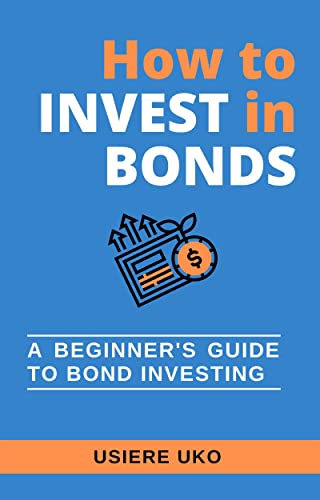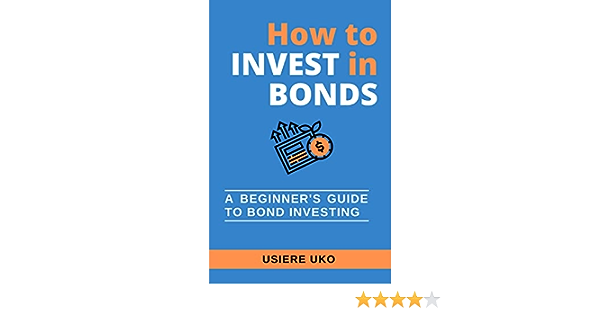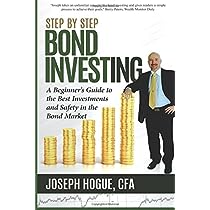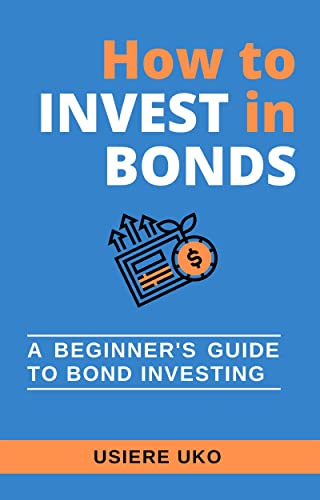Have you ever thought about investing in bonds but don’t know where to start? Well, you’re in the right place! Welcome to “A Beginner’s Guide to Investing in Bonds.” Here, we will provide you with all the information you need to confidently navigate the world of bonds and make informed investment choices.
Investing in bonds can be a great way to diversify your portfolio and earn a steady income. In this guide, we will cover everything from the basics of bonds to the different types available and the factors to consider before investing. We will break down the jargon and provide practical tips to help you understand the ins and outs of bond investing. By the end of this guide, you’ll have the knowledge and confidence to take your first steps into the world of bond investment. So, let’s get started and learn how to invest in bonds together!

This image is property of Amazon.com.
Understanding Bonds
What is a bond?
A bond is a type of financial instrument that represents a loan made by an investor to a borrower, typically a government or corporate entity. When you invest in a bond, you are essentially lending your money to the borrower in exchange for periodic interest payments and the return of the principal amount at maturity. Bonds are considered fixed-income securities, as they provide a predetermined rate of return.
How do bonds work?
When you purchase a bond, you are effectively becoming a creditor of the issuer. The bond issuer promises to make regular interest payments, known as coupon payments, for the duration of the bond’s term. Bonds typically have a fixed maturity date, which is when the issuer is obligated to repay the principal amount. The interest rate on the bond, known as the coupon rate, is usually set at the time of issuance and remains constant throughout the life of the bond.
Types of bonds
There are several types of bonds available for investors, each with its own characteristics. Government bonds, also known as treasuries, are issued by national governments and are considered to be low-risk investments. Corporate bonds, on the other hand, are issued by companies to finance their operations and may offer higher yields but come with a higher level of credit risk. Municipal bonds are issued by state and local governments to fund public projects and are typically exempt from federal taxes. Other types of bonds include mortgage-backed securities, convertible bonds, and foreign bonds.
Benefits of Investing in Bonds
Regular Income
One of the primary benefits of investing in bonds is the regular income they provide. Unlike stocks, which can be volatile in terms of dividends, bonds offer predictable interest payments at regular intervals. This makes bonds an attractive option for investors who rely on a steady stream of income, such as retirees or individuals looking to supplement their salary.
Capital Preservation
Another advantage of investing in bonds is the potential for capital preservation. While the value of stocks and other assets can fluctuate greatly, bonds tend to be more stable. When you invest in a bond, the issuer has a legal obligation to repay the principal at maturity. This can provide a level of assurance that your original investment will be returned, assuming the issuer remains solvent.
Diversification
Investing in bonds can also help diversify your investment portfolio. By spreading your investments across different asset classes, you can reduce the overall risk associated with your portfolio. Bonds have historically had a low correlation with stocks, meaning they often perform differently during market fluctuations. This diversification can help offset any losses incurred in other parts of your portfolio.
Fixed Interest Payments
Unlike other investments where the rate of return may vary, bonds offer fixed interest payments. This can be particularly attractive in a low-interest-rate environment, as it ensures a stable income stream. Fixed interest payments can also make it easier to budget and plan for expenses, as you know exactly how much income you will receive from your bond investments.
Various Risk Levels
Bonds offer a range of risk levels to suit different investor preferences. Government bonds, particularly those issued by stable countries, are generally considered to be low-risk investments. On the other end of the spectrum, high-yield or junk bonds carry a higher level of risk but also offer the potential for higher returns. Investors can choose bonds that align with their risk tolerance and investment objectives.

This image is property of Amazon.com.
Factors to Consider Before Investing
Risk Tolerance
Before investing in bonds, it’s important to assess your risk tolerance. Some bonds, such as government bonds, come with low risk but also offer lower returns. If you have a low risk tolerance and prioritize capital preservation, these may be the ideal investment for you. However, if you are comfortable with taking on more risk for the potential of higher returns, you may opt for corporate bonds or other higher-yield bonds.
Investment Timeframe
Your investment timeframe is another crucial factor to consider when investing in bonds. Bonds typically have set maturity dates, which may range from a few years to several decades. If you have a short-term investment horizon, you may prefer bonds with shorter maturities that align with your financial goals. For long-term investors, bonds with longer maturities may be more appropriate.
Current Market Conditions
Market conditions can greatly impact the performance of bonds. Interest rates, inflation rates, and overall economic stability can all influence bond prices. It’s important to assess the current market conditions and consider how they may affect your bond investments. For example, if interest rates are expected to rise, existing bond prices may decrease. On the other hand, a decline in interest rates can result in higher bond prices.
Creditworthiness of the Issuer
When considering bond investments, it’s crucial to evaluate the creditworthiness of the issuer. The creditworthiness refers to the issuer’s ability to fulfill its financial obligations, including making interest payments and repaying the principal amount. Bond rating agencies, such as Moody’s and Standard & Poor’s, provide credit ratings for different bonds, indicating the level of credit risk associated with the issuer. Investors should carefully assess the creditworthiness of the issuer before investing in a bond.
Bond Ratings
Bond ratings provide investors with an indication of the creditworthiness of the issuer. Ratings agencies assign ratings based on their evaluation of the issuer’s financial strength and ability to repay its obligations. Bonds with higher ratings, such as AAA or AA, are considered to have lower credit risk and are generally safer investments. Lower-rated bonds, such as those rated B or below, come with a higher level of credit risk but may offer higher yields.
How to Buy Bonds
Choosing a Brokerage Account
To buy bonds, you will typically need to open a brokerage account. There are several reputable brokerage firms that offer bond trading services. When choosing a brokerage account, consider factors such as account fees, customer service, and the platform’s user-friendliness. It’s also important to ensure that the brokerage firm offers access to the types of bonds you are interested in.
Researching Bonds
Before purchasing bonds, it’s essential to do thorough research. Evaluate the different types of bonds available and the issuers offering them. Consider factors such as the issuer’s creditworthiness, the bond’s maturity date, and the interest rate or coupon rate. You can access bond information through financial news networks, bond trading platforms, or by consulting with a financial advisor.
Placing an Order
Once you have selected the bonds you wish to invest in, you can place an order through your brokerage account. Specify the quantity of bonds you wish to purchase and any other relevant details, such as the desired yield or coupon rate. Your brokerage platform will guide you through the process of placing an order and provide confirmation once the order is executed.
Bond Pricing
Bond pricing can be complex, as it is influenced by various factors such as interest rates, credit risk, and market demand. The price of a bond is typically quoted as a percentage of its face value or par value. Bonds may trade at a discount, meaning the price is below the face value, or at a premium, meaning the price is above the face value. Understanding bond pricing is essential when evaluating potential investments.

This image is property of Amazon.com.
Evaluating Bond Investments
Yield
Yield is an important metric to consider when evaluating bond investments. It represents the effective rate of return an investor can expect to receive from holding the bond. Yield takes into account both the interest payments and any fluctuation in the bond’s price. Higher yields generally indicate higher returns but may also come with higher risk.
Coupon Rate
The coupon rate is the fixed interest rate that the bond issuer pays to bondholders. It is expressed as a percentage of the bond’s face value and remains constant throughout the life of the bond. The coupon rate influences the regular income generated from the bond and is an essential factor to consider when assessing potential returns.
Maturity Date
The maturity date of a bond is the date on which the issuer is obligated to repay the principal amount. It is crucial to consider the maturity date when evaluating bond investments, as it determines the length of time your money will be tied up in the bond. Shorter-term bonds offer greater liquidity, allowing you to access your investment sooner, while longer-term bonds may offer higher yields but come with a longer time commitment.
Credit Rating
As mentioned earlier, the credit rating of a bond issuer is an important consideration. A higher credit rating indicates a lower risk of default, providing investors with a level of security. Lower-rated bonds may offer higher yields, but they come with an increased risk of the issuer being unable to meet its financial obligations. Evaluate the credit ratings of issuers to gauge the level of credit risk associated with their bonds.
Bond Liquidity
Liquidity refers to how easily a bond can be bought or sold in the market. Highly liquid bonds have a large volume of trading activity, making it easier for investors to buy or sell their positions without impacting the market price significantly. Bonds with lower liquidity may be more challenging to sell, resulting in longer wait times or potentially selling at unfavorable prices. Consider the liquidity of a bond before investing, especially if you may need to access your funds before the bond’s maturity.
Investment Strategies
Buy and Hold
The buy-and-hold strategy involves purchasing bonds and holding them until maturity. This strategy allows investors to benefit from the fixed interest payments and the return of the principal amount. Buy-and-hold investors prioritize capital preservation and a steady income stream. This strategy is suitable for those with a long-term investment horizon and a low tolerance for market fluctuations.
Laddering
Laddering involves spreading investments across bonds with different maturity dates. By staggering the bond maturities, investors can reduce interest rate risk and potentially capture higher yields. As shorter-term bonds mature, investors can reinvest the proceeds into longer-term bonds, taking advantage of potentially higher interest rates. Laddering provides a balance between maximizing returns and maintaining flexibility.
Bond Funds
Bond funds pool investors’ money to invest in a diversified portfolio of bonds. This allows investors to access a range of bonds with varying characteristics, such as different issuers, maturities, and credit ratings. Bond funds are managed by professional portfolio managers who make investment decisions on behalf of the fund. Investing in bond funds provides instant diversification and can be suitable for investors with a smaller investment amount.
Bond ETFs
Bond ETFs (exchange-traded funds) are similar to bond funds but trade on the stock exchange like a stock. ETFs provide investors with the flexibility to buy and sell shares throughout the trading day. Bond ETFs offer the benefit of diversification and accessibility while allowing investors to take advantage of intraday price movements. Like bond funds, ETFs are managed by professional portfolio managers.

This image is property of Amazon.com.
Risks of Bond Investing
Interest Rate Risk
One of the primary risks associated with bond investing is interest rate risk. When interest rates rise, existing bond prices tend to decrease, as newly issued bonds offer higher coupon rates. This can result in capital losses if you sell your bonds before maturity. Conversely, when interest rates fall, bond prices tend to rise. Understanding and managing interest rate risk is crucial to mitigate potential losses.
Credit Risk
Credit risk refers to the risk of an issuer defaulting on its financial obligations, such as interest payments or repayment of the principal amount. Bonds with lower credit ratings carry a higher level of credit risk, as the issuer may have a higher likelihood of defaulting. Assessing the creditworthiness of the bond issuer is essential when investing in bonds to mitigate credit risk.
Inflation Risk
Inflation risk is the risk that rising inflation rates will erode the purchasing power of the bond’s future cash flows. If the interest rate on a bond does not keep pace with inflation, the bondholder may experience a decrease in the real value of their investment. Bonds with longer maturities are particularly susceptible to inflation risk, as the impact of inflation is compounded over time.
Call Risk
Call risk arises when a bond issuer decides to redeem or call back their bonds before the maturity date. This usually occurs when interest rates decline, and the issuer can issue new bonds at a lower interest rate. When a bond is called, investors may face reinvestment risk, as they may need to reinvest the proceeds at lower interest rates. Evaluating the call provisions of a bond is essential to assess the potential call risk.
Taxes and Bonds
Taxation of Bond Profits
The taxation of bond profits varies depending on the type of bond and the investor’s tax situation. Generally, the interest earned from bonds is subject to federal income tax. However, certain types of bonds, such as municipal bonds, may be exempt from federal taxes. It’s important to consult with a tax professional or financial advisor to understand the tax implications of your bond investments.
Tax-Exempt Bonds
Municipal bonds, also known as munis, are issued by state and local governments to fund public projects. One significant advantage of municipal bonds is their tax-exempt status. The interest earned from municipal bonds is generally exempt from federal taxes and may also be exempt from state and local taxes if you reside in the issuing state. Tax-exempt bonds can be an attractive option for investors seeking to minimize their tax liability.
Taxable Bonds
Other types of bonds, such as corporate bonds and government bonds, are typically subject to federal income tax. The interest earned from these bonds is treated as taxable income. The tax rate will depend on the investor’s tax bracket. It’s important to factor in the tax implications when evaluating the potential returns from taxable bonds.

This image is property of miro.medium.com.
Monitoring Bond Investments
Tracking Bond Performance
Monitoring the performance of your bond investments is essential to ensure they align with your investment objectives. Keep track of any changes in interest rates, credit ratings, or the financial health of the bond issuer. Regularly review financial statements, news updates, and performance reports to stay informed about your bond investments.
Rebalancing
Rebalancing is the process of adjusting your investment portfolio to maintain the desired asset allocation. As bond prices and interest rates fluctuate, your portfolio may become unbalanced. Rebalancing involves selling or buying bonds to bring your portfolio back in line with the target allocation. It’s important to periodically reassess your investment objectives and rebalance your bond holdings accordingly.
Staying Informed
Staying informed about the bond market is crucial to make informed investment decisions. Read financial news, follow economic indicators, and stay updated on market trends. By staying informed, you can identify potential opportunities or risks within the bond market and adjust your investment strategy accordingly.
Conclusion
Investing in bonds can be a valuable addition to an investment portfolio, providing regular income, capital preservation, and diversification benefits. However, before investing in bonds, it’s crucial to consider factors such as risk tolerance, investment timeframe, market conditions, and the creditworthiness of the issuer. Understanding bond pricing, evaluating bond investments, and implementing suitable investment strategies can help optimize your bond portfolio. By monitoring bond investments and staying informed about the bond market, you can make well-informed decisions and potentially achieve your investment goals.












